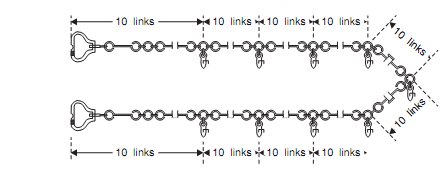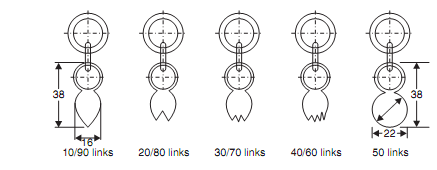Chains
Chains are composed of 100 pieces of 4 mm diameter galvanised mild steel wires bent into rings at the end and joined to each other by 3 circular or oval shaped rings. These rings provide flexibility to the chain. Ends of chains are provided with swivel joints

(a)

(b)
Chain
So that without twisting the chain can be turned. Brass tallies are provided to facilitate easy reading of the chain. with a talley of one tooth End of 10th link from each end is provided, with a talley of two teeth 20th link is provided; with a talley of three teeth 30th link; with a talley of 4 teeth 40th link and with a talley of circular shape the middle of chain is provided as shown in figure b.
It is to be noted that
- Length of a link is distance between the centres of two consecutive middle rings.
- And the length of the chain is from outside of one handle to the outside of the other handle. Frequently used metric chains are of 20 m length. They have 100 links at every 2 m with talleys.
Each link is of 0.2 m length. At every one metre length except wherever tallies are provided Simple rings are provided. Total length of chain is marked on the brass handle.
However 30 m chains are in use also. Since no rings can be provided at one metre distance and with 0.3 to arrive at metre units each link requires multiplication, Length of each link is 0.3 m. It is not as convenient as 20 m chain to read. Still as a result the influence of using 100 ft chain in olden days, this type of chain is also in market.